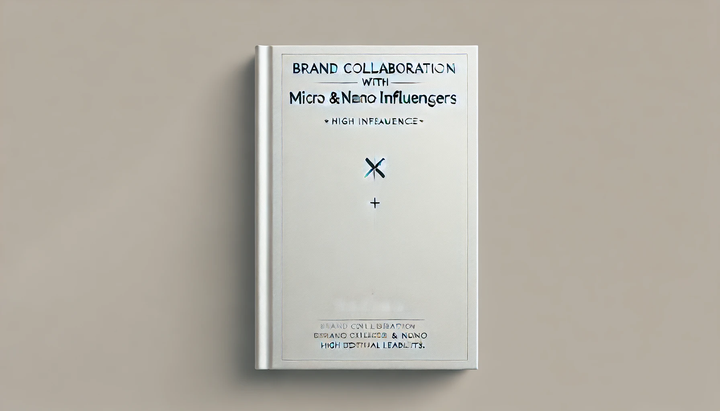Brand Collaboration with Micro & Nano-Influencers: Benefits & Best Practices

Introduction
In today's digital marketing landscape, brand collaboration with micro & nano-influencers has become a game-changer for businesses. With traditional advertising losing its effectiveness and consumers craving authenticity, brands are turning to smaller influencers to drive engagement and build trust. This blog explores why brands should collaborate with micro and nano influencers, the benefits they offer, and best practices to ensure successful partnerships.
Understanding Micro and Nano-Influencers
Before diving into the benefits and strategies, it’s essential to understand who micro and nano influencers are:
- Micro-Influencers: Typically have 10,000 to 100,000 followers. They specialize in niche content and have a highly engaged audience.
- Nano-Influencers: Usually have 1,000 to 10,000 followers. They have an intimate and highly loyal community, making them incredibly influential in their small circles.
Unlike celebrities or macro-influencers, micro and nano-influencers interact more personally with their followers, resulting in higher trust levels and better engagement rates.
Benefits of Brand Collaboration with Micro and Nano Influencers
Higher Engagement Rates:
Micro and nano-influencers generally have higher engagement rates compared to macro influencers and celebrities. Studies show that nano influencers can have engagement rates as high as 7-10%, whereas macro-influencers typically average around 1-3%. This means brands get more value for their investment.
Cost-Effectiveness Compared to Macro and Celebrity Influencers
Collaborating with high-profile influencers can cost brands thousands of dollars per post. In contrast, micro and nano-influencers charge significantly less or may even promote products in exchange for free merchandise or commissions on sales. This makes them an excellent option for startups and small businesses.
Authenticity and Trust Factor
Consumers today prefer recommendations from real, relatable people rather than celebrities. Since micro and nano-influencers engage directly with their audience, their endorsements feel genuine and trustworthy.
Stronger Niche Audience Targeting
Micro and nano-influencers often focus on specific niches such as fitness, beauty, tech, travel, or parenting. This allows brands to reach the right audience without wasting marketing budgets on broader demographics that may not convert.
Higher Conversion Rates and ROI
Due to their loyal and engaged followers, micro and nano-influencers drive higher conversion rates. Reports indicate that campaigns with micro-influencers achieve 60% higher campaign ROI compared to traditional influencer marketing.
Improved Brand Loyalty and Long-Term Partnerships
Working with smaller influencers helps brands build long-term relationships rather than one-off campaigns. These influencers genuinely care about the brands they endorse, leading to ongoing partnerships and stronger brand loyalty among their followers.
Best Practices for Collaborating with Micro and Nano Influencers
Finding the Right Influencer for Your Brand
- Use platforms like ryme.ai to discover suitable influencers.
- Look for influencers whose values align with your brand message.
- Analyze their engagement rates, audience demographics, and authenticity.
Setting Clear Goals and Expectations
- Define your objectives: Brand awareness, sales, engagement, or content creation.
- Provide influencers with a clear campaign brief including guidelines and deliverables.
Offering Fair Compensation and Incentives
- Compensation can include monetary payments, free products, affiliate commissions, or exclusive perks.
- Value their work fairly to encourage stronger commitment and better content.
Encouraging Creative Freedom and Authenticity
- Allow influencers to craft content in their own style and voice.
- Audiences respond better to organic storytelling rather than scripted promotions.
Leveraging Multiple Influencers for Wider Reach
- Running campaigns with multiple micro & nano-influencers can amplify brand reach.
- Instead of one macro-influencer, collaborate with 10-20 micro/nano-influencers for better ROI.
Tracking Performance and Measuring Success
- Use analytics tools like Google Analytics, ryme.ai, and Instagram Insights.
- Track KPIs such as engagement rates, click-through rates, sales conversions, and brand mentions.
Challenges in Brand Collaboration with Micro and Nano Influencers
Despite the advantages, brands may face challenges such as:
- Scaling influencer campaigns efficiently – Managing multiple micro-influencer collaborations requires streamlined coordination.
- Maintaining brand consistency – Different influencers have varied content styles, so it’s important to balance creative freedom with brand messaging.
- Avoiding fake followers & engagement – Some influencers buy fake followers. Use tools like HypeAuditor or Social Blade to verify authenticity.
Future of Micro and Nano-Influencer Marketing
- Rise of AI-powered influencer marketing platforms (e.g., ryme.ai automating brand-influencer matchmaking).
- More brands shifting ad budgets to micro & nano-influencers due to better cost-effectiveness.
- Greater focus on long-term partnerships rather than one-time collaborations.
Conclusion
Brand collaboration with micro & nano-influencers is reshaping the marketing industry by offering authenticity, higher engagement, and cost-effective solutions. By following best practices—such as choosing the right influencers, setting clear goals, and measuring performance—brands can maximize the success of their influencer marketing campaigns.
Ready to boost your brand’s reach with micro & nano-influencers? Start collaborating today with ryme.ai—your go-to platform for seamless influencer marketing.

